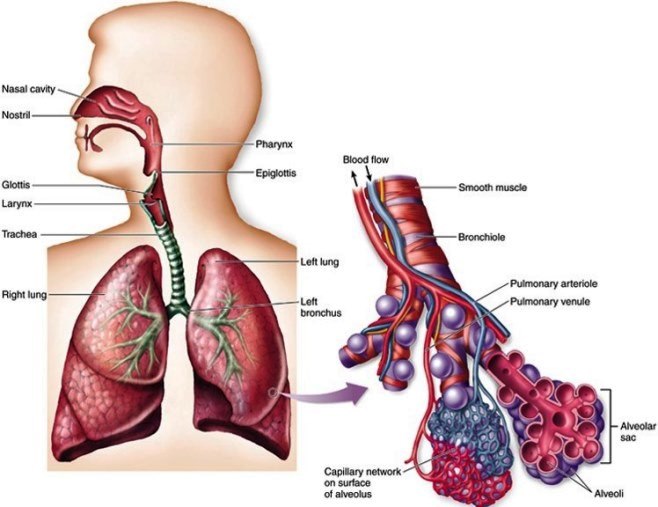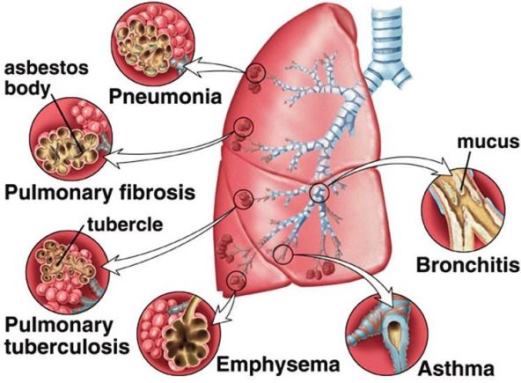Key Concepts
Dysfunction of the respiratory system, which supplies the body with the oxygen needed for metabolic activities in the cells and removes carbon dioxide, a product of cellular metabolism. The respiratory system (Fig. 1) includes the nose, mouth, throat, larynx, trachea, bronchi, lungs, and the muscles of respiration, such as the intercostal muscles and the diaphragm. The inspiratory movements of the chest wall and diaphragm suck air through the nose, throat, larynx, trachea, and bronchi into the lung alveoli, where it comes into close contact with the blood circulating in the capillaries and gas exchange occurs. During expiration, this air is expelled through the same pathway. For proper respiratory function, the right ventricle of the heart pumps venous blood, containing carbon dioxide, through the pulmonary arteries into the lung capillaries, where gaseous exchanges between the blood and air occur. The arterial or oxygenated blood is then drained through the pulmonary veins into the left atrium. Serious and often life-threatening consequences can result when respiratory system disorders occur. See also: Carbon dioxide; Lung; Metabolism; Oxygen; Respiration; Respiratory system

Symptoms and signs
The lung has a great reserve capacity, and therefore a significant amount of disease usually must be present to produce clinical signs and symptoms (Fig. 2). Shortness of breath (dyspnea) on exertion is the most common symptom of a respiratory disorder. Shortness of breath while at rest is indicative of severe respiratory disease and usually implies a severe abnormality of the lung tissue. If the respiratory system is so diseased that normal oxygenation of the blood cannot occur, blood remains dark, and a bluish color can be seen in the lips or under the fingernails; this condition is referred to as cyanosis. If the process continues and hypoxia develops, in which insufficient oxygen is supplied to vital organs such as the brain and heart, a person will become unconscious and die. Other signs and symptoms of respiratory disorder can include fever, chest pain, coughing, excess sputum production, and hemoptysis (coughing up blood). Most of these signs and symptoms are nonspecific. See also: Hypoxia

Diseases of the air passages
Most diseases of the airways increase the resistance against which air is sucked in and pushed out of the lungs. The effect of a disease of the airways depends largely on its localization. Diseases of the nose usually have little influence because collateral respiration through the mouth compensates easily. Diseases of the throat, larynx, and trachea can significantly inhibit the flow of air into the lungs. Infections in the back of the throat, such as in diphtheria, can cause marked swelling of mucous membranes, resulting in air obstruction. Edema (swelling) of the mucosal lining of the larynx also can cause a reduction in air flow. Likewise, air flow can be inhibited in asthma, in which the smooth muscle in the trachea and bronchi episodically constricts (Fig. 2). Chronic bronchitis, which is caused predominantly by cigarette smoking, results in inflammation of and excess mucus production by the bronchi and this also can lead to a reduction in air flow (Fig. 2). Bronchiolitis, a condition that usually occurs in children and is often caused by a respiratory virus, results in narrowing and inflammation of small airways and a decrease in air flow. See also: Asthma
Diseases of the lungs
Pneumonia, cancer, emphysema, and tuberculosis are the most common lung diseases (Fig. 2) and are major causes of morbidity and mortality.
Pneumonia is caused by bacteria, viruses, and other infectious agents that result in inflammation and consolidation (solidification) of the gas exchange units of the lung (alveoli). Persons with pneumonia frequently develop fever, chest pain, and rapid breathing. When the disease involves a significant portion of the lung, shortness of breath may develop. See also: Pneumonia
The most common form of pulmonary emphysema is centrilobular emphysema, and it is caused by cigarette smoke. This disease usually involves the upper lobes of the lungs and is characterized by the breakdown and permanent loss of lung tissue, resulting in large cystic spaces in the lung referred to as blebs. Emphysema is usually associated with chronic bronchitis, and individuals with the combination of diseases, often termed chronic obstructive pulmonary disease (COPD), will often have shortness of breath on exertion and usually have excess sputum production. See also: Chronic obstructive pulmonary disease (COPD); Emphysema
Approximately 90% of lung cancers can be attributed to the carcinogens present in cigarette smoke. Lung cancer may be detected in asymptomatic persons with a routine chest x-ray, or it may be discovered as a result of pain, excess coughing, or hemoptysis. See also: Cancer
Tuberculosis (also known as consumption) is a chronic disease that primarily involves the lungs, although other parts of the body can be affected. It is caused by the tubercle bacillus Mycobacterium tuberculosis. When infected with this organism, the individual develops a delayed hypersensitivity response that surrounds the bacteria with macrophages and B and T lymphocytes, forming a walled-off area called a granuloma. Granulomas are referred to as tubercles and are characteristic of the disease. See also: Macrophage; Tuberculosis
Pulmonary circulatory diseases
Among the diseases of pulmonary circulation, congenital malformations of the heart and pulmonary artery account for many cases of respiratory insufficiency in newborn and younger children; those affected are called blue babies because they appear cyanotic. In adults, acquired heart diseases, such as narrowing of the valve between the left atrium and left ventricle (mitral stenosis), can cause backup of blood into the lung and an increased pressure in the pulmonary circulatory system. Also, blood clots, which usually develop first in the deep veins of the legs, can break free and flow to the heart. Once there, they enter the pulmonary arteries and wedge in their small branches, where the clots are referred to as pulmonary thromboemboli, and can cause areas of death in the lung tissue (pulmonary infarcts). Persons who develop thromboemboli usually have chest pain and shortness of breath, and some have hemoptysis. See also: Cardiovascular system; Circulation disorders
Neuromuscular diseases
Some neuromuscular diseases, including poliomyelitis and amyotrophic lateral sclerosis (Lou Gehrig's disease), can cause dysfunction of the muscles of respiration. The resulting inability of these muscles to move air into the lungs can cause severe shortness of breath and predispose the patient to pneumonia. See also: Muscular system disorders; Poliomyelitis





